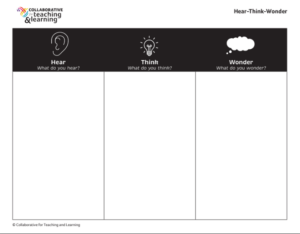STRATEGY FOCUS
SEE-THINK-WONDER
PURPOSE
Adapted from Harvard’s Project Zero, the See-Think-Wonder strategy provides students with a structured approach to interacting with new content that is primarily visually based, such as art, diagrams, and images. While looking at the content, students work their way through the thinking process: What do you see? What does it make you think? What do you wonder about? While writing down their responses to the questions, this quick process provides students with time to think and process the content.

PROCESS
- Begin by providing students with the desired content (art, photograph, video clip, political cartoon, visual media, etc.) that is accessible for all students and lends itself to deep analysis.
- Provide the students with the three column organizer or simply have students draw three columns on paper labeling them See, Think, and Wonder.
- Display or pass out copies of the content to students and pose the three questions in order. Be sure to pause after each question, giving students time to reflect, process, and respond.
-
- What do you see? This is limited to observations, not interpretation of what students see. Have students write down everything they see.
- What do you think about what you see? This is what students think is going on and their rationale. Probe students to look closer and deeper at the content.
- What do you wonder about what you see? This is where students can go much deeper with the content by asking high-level questions and things they wonder about.
Note: A single observation should be taken across all three columns of the See-Think-Wonder organizer. In the “think” column, students will create a thought about what they identified in the “see” column. In the “wonder” column, students will create a wonder statement about a curiosity they have about what they identified in the same “see” column. The process is linear.
PROBING QUESTIONS
CONSIDERATIONS
- How does using See-Think-Wonder help you think about the content?
- Which part of See-Think-Wonder did you find most difficult?
- How does the thought process you used in See-Think-Wonder transfer to real life?
- It is recommended that teachers use the gradual release process with this strategy to make sure students are making threaded connections. Provide the students with a Think Aloud about how you might fill out one See-Think-Wonder. The next example might start with a student sharing a See, and giving the group time to pair-share before getting input from the class for the associated Think, and repeating for the associated Wonder. Lastly, let students work in pairs to create their own See-Think-Wonders before releasing them to work on more challenging content.
- After students respond to the questions, you might use an Academic Dialogue strategy (such as Think-Ink-Pair-Share) to engage students in dialogue around the content.
- Use students’ observations, thoughts, and wonders to engage in further discussion and investigation of the content.
CONTENT APPLICATIONS
![]()
SOCIAL STUDIES
Before beginning a unit on The Great Depression, students look at photographs from that time period and use See-Think-Wonder to spark thinking.

ARTS & HUMANITIES
When studying Realism in an art classroom, students look at a variety of works of art from that time period and use See-Think-Wonder to explore the characteristics.
![]()
CAREER & TECHNICAL EDUCATION
SIn a construction class, students look at a picture of a house in the construction phase and use See-Think-Wonder to explore home construction.
![]()
MATHEMATICS
In a mathematics classroom, students look at a graph and use See-Think-Wonder to help with interpreting the data in the graph.
PDF REPRODUCIBLE


